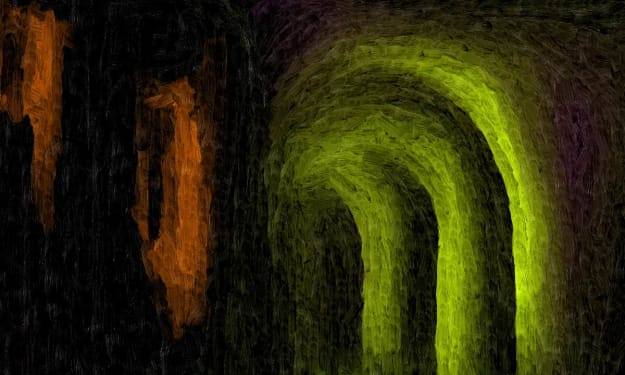
Nobody can hear a scream in the vacuum of space, or so they say.
Rain conceded that they did say that. Hurtling toward the surface of an icy moon orbiting a gas giant seventy thousand light years from home, however, she wasn’t so sure. Screams were shockwaves traveling through a gaseous medium, or something like that. The denser the medium, the faster the scream traveled. Or maybe it was louder – or it was both faster and louder. Either way, space was not dense and therefore no shockwaves.
She accepted the premise.
Except there were shockwaves in space. Assuming the screamer’s lungs started with air, that air would expand kind of like a tiny supernova without gamma rays. If somebody was close enough, the tiny supernova would hit them. If their ears were exposed, they were doing some screaming of their own. The two together might “hear” the impact of one another’s respective expanding gas shells.
Speaking of expanding, and by extension expansiveness – “nobody” was an arbitrarily expansive word. If one or more gods existed, they fit within the scope of somebodies. An omnipotent god does anything it wants. “Anything” was another arbitrarily expansive word. Hearing people scream in space fit within the orbit of anything, and therefore the statement “nobody can hear a scream in the vacuum of space” represented an implicit assertion there was no omnipotent god. Rain hoped nobody ratted her out to the god wallowers for thinking such a thing.
Could a merely potent god hear space screams?
A merely potent god could exist in the vacuum without the need for personal protective equipment. Rain was a high category cybernetic organism. That was one kind of merely potent god. What few living cells she had left required oxygen, but she could get it from sources other than lungs. That was fortunate, because she didn’t have lungs. She did have powerful optical systems that saw awfully far, and an understanding of what it looked like when someone screamed. When her eyes processed moving lips as speech, she “heard” her own head voice. She should therefore hear her own head voice screaming. As a telepath, she could even hear the screamer’s head voice screaming – if they were close enough.
Nobody was close enough. As far as Rain knew, hers was the only at least partially organic brain within bajillions of kilometers. If artificial intelligences made impressions on the root intellect in up down space, or whatever, Rain was not a sophisticated enough telepath to pick them up. The mission barge’s artificial intelligences were probably doing a form of screaming, though. As far as Rain could tell, the filament loop malfunctioned shortly after arrival and the barge either blew up, hit something, blew up after hitting something, or an antediluvian defense mechanism at the terminal complex caused mayhem.
Rain couldn’t say “they” didn’t warn her.
Despite being anchored above Keter Gaia Tikal Aleph, the filament was incredibly faint. That meant it was incredibly old. There were thirteen Grand Disjunctions on record in the Thousand Tears of Bahamut – home. After each disjunction, fifty thousand years of nothing was followed by fifty thousand years of the next reinitialized civilization. On average. So if Rain grokked the math, all the filaments connecting the thousand stars of home went back one point three million years.
If a filament was faint relative to that, it went back more than one point three million years. How much more, Rain lacked the expertise to guess authoritatively. Keter Gaia Tikal Aleph’s fossil record suggested the planet was a barren rock until the Root Civilization found it. Nobody pretended to guess how far back the Root Civilization went.
Getting ejected from a crumbling space barge had kicked Rain’s processors into “oh shit” drive and almost no time had passed thinking about all this. The trivial diversion occupied her thoughts for a few moments, however, and that kept her from spinning into a panic. There was no need to panic – or even scream. Her coffin’s integrity was one hundred percent.
Maybe the space gnomes could have come up with a better word than “coffin.”
But it was a rectangular solid several meters this way and that. A compartment in the middle fit her exactly, so the coffin reference was fair. The mission barge was a solid chunk of ceramic metal alloys. It slotted things in like industrial facilities, vaporizer beams, and passenger coffins. It was a coffin of coffins. Sepulcher? Mausoleum? Rain was the only passenger – not counting the robots.
Maybe she should count them. They were helpful, and she hoped as many of them got through this as possible. Right. Back to it. “This” was a few hundred kilometer drop onto the crust of any icy moon orbiting a gas giant. The Root Civilization filament terminated above this moon. That implied an abundance of Root Civilization Infrastructure beaming Root Interface through the vacuum of space. Rain could hack it.
Wires in her head found the interfaces quickly enough. The primitives were as raw as raw got. Rawer than anything Rain worked with previously. Back home, thirteen generations of reinitialized civilizations built had slathered macros galore on top of the Root primitives. Rain was sure the Root Civilization itself employed higher functions, but no contemporary civilization’s space gnomes had figured out any of that yet.
No matter. Rain could work with raw Root.
Gravity was her biggest enemy at that moment. Relative to taking an afternoon stroll on the surface of a standard rocky planet, there wasn’t much gravity a couple hundred kilometers above a gas giant’s ice moon. But mission barges packed plenty of mass into a few kilometers of length, a couple hundred of width, and a hundred of thickness. Nobody walked in a space barge.
Now, Rain, what did you just say?
“Nobody” was arbitrarily expansive. An extra dimensional somebody might walk around inside a space barge. An artificial intelligence might associate itself with different processing units spread through the superstructure. Moving from one to others could qualify as “walking.” But Rain did not walk around inside a solid chunk of ceramic metal. Unaugmented humans walked less. Their coffins used Root interface macros to change the fundamental laws of the universe and freeze their wave equations in place. Or something. Rain’s equations had only mostly been frozen.
Her cybernetic brain was allowed to continue moving electrons around.
Gravity. Right.
Rain moved electrons around to tell the Root interface this icy moon and her former barge’s solid metallic ceramic alloy chunks felt too much “G” for the “r” separating them. Sure, it was the natural amount of G (whatever amount that was), but Rain required G to drop an order of magnitude between the moon and the good guys.
Her coffin’s arrays visualized multidimensional layers of good guy pieces, using degrees of transparency to forecast trajectories. Rain highlighted each piece, then all of them together in less than a blink, and rewrote universal laws where necessary to keep them together instead of cratering. Her Root Interface rating was damn high – among the highest. So was her cybernetic recombooberation. Preventing space barge chunks from cratering on an ice moon was not a big ask for Root interface shenanigans. She wasn’t trying to separate the moon from the gas giant, after all.
Yet.
Hold that thought.
Readjusting values of G several hundred times a second, then a minute, then an hour, she got her space debris into a stable orbit around the moon (which was large enough to be a small planet – if one were inclined to go down that hole). She could have done it asleep if the moon had been a small rogue planet drifting through interstellar space. Some space gnomes were able to account for nearby bodies in advance when working Root interface magic. Rain had required some trials, and made a lot of errors, accounting for the moon’s gas giant. The star also messed things up more than she would have expected. The gas giant was neither far nor close to its mommy. The giant’s other moons were less of an issue than Rain anticipated. It all worked out.
In order to prevent losing any important debris to space, or the gas giant, Rain erred on the side of crashing pieces she couldn’t get under control into ice. Of all the crusts she might have had to deal with, ice was best. In addition to being a smooshy landing, ice meant a whole lot of oxygen was a few electrochemical processes away. Rain had no lungs, and wouldn’t scream even if she ejected from her coffin into the vacuum of space (for reasons). But oxygen remained critical to her ability to fix this mess before reaching her expiry date.
Where fortune gave, fortune took. The ice moon was perfect. The gas giant was going to be a problem. It was big enough to qualify as impressive, but was nowhere near the largest size possible under natural G. Its size wasn’t a problem per se, but it had one killer magnetic field – and spat out an excessive amount of radiation.
Gas giants stuffed with Root Civ Infrastructure were like that.
In fact, based on gas giants in the Thousand Tears of Bahamut, this one was in the top tenth of a percent of “gas giants whoever built all this loved.” It might even have been the best. That reinforced the age of this filament. Root Civilization Infrastructure was capable of moving celestial bodies around. It wasn’t the sort of thing any contemporary civilization could manage, but space gnomes ran all the math a while back and figured out planets like Keter Gaia Tikal Aleph were the result of engineered collisions and heat transfer and blah blah blah. The infrastructure inside this gas giant had more than one point three million years to make everything perfect.
Rain’s cybernetic brain refused to accept those numbers at face value. But they were neither here nor there. Even if she couldn’t rework the orbitals of this star system to make a perfect gas giant, she had worked enough Root magic to keep her ticket home out of existential danger. Her remaining tasks were more mundane: put the barge back together; figure out what went wrong; avoid repeating.
Then she could get on with the actual mission.
Because damn.
Not to fluff her own accomplishments, but the Tears of Bahamut stretched about a thousand light years. The filaments connecting them were well understood and never had accidents. An accident was only to be expected trying to reach the other end of a filament older than anything else in the Tears and seventy thousand light years away. Once again, damn. She was awesome.
And she was going to make damn sure they knew about it back in Tikal Aleph.
About the Creator
Matthew Melmon
Sold EA stock too soon. Left Apple too soon. Started personalized music service... Dot Com pop. Events discovery. Nope. Video. Nope. Solar panels. DiFi. Personal growth non-profit. All nope. The Beatles got it right: write paperbacks.
Enjoyed the story? Support the Creator.
Subscribe for free to receive all their stories in your feed. You could also pledge your support or give them a one-off tip, letting them know you appreciate their work.






Comments
There are no comments for this story
Be the first to respond and start the conversation.